Project Based Learning
> Davecookson
Engaging Students in Work That Matters. On the eve of project fortnight. Tips for project-based learning. Project-based learning has the potential to teach key skills and knowledge in a more engaging and real-world way.

Earnie Kramer looks at the pros and cons and offers some advice.
Schools Don't Have To Be Endured. Critique and Feedback: 3rd Graders at Presumpscot Elementary. Navig8 flipbook. Student discounts, deals & offers for premium software in UK - Software4Students. Connected Learning: Interdisciplinary Researchers Recommend Core Changes. It has been almost a year since the release of the connected learning principles in March 2012 on connectedlearning.tv.
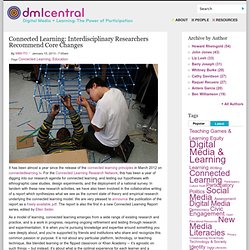
For the Connected Learning Research Network, this has been a year of digging into our research agenda for connected learning, and testing our hypotheses with ethnographic case studies, design experiments, and the deployment of a national survey. In tandem with these new research activities, we have also been involved in the collaborative writing of a report which synthesizes what we see as the current state of theory and empirical research underlying the connected learning model. We are very pleased to announce the publication of the report as a freely-available pdf. The report is also the first in a new Connected Learning Report series, edited by Ellen Seiter.
Design Thinking for Educators. Walk with me a while across the sand. Ron Berger’s An Ethic of Excellence should be required reading on every Teacher Training course in the country;it synthesises the craft of teaching and inspires it in equal measure.A year after reading it,I am still learning from it and still reflecting on its power,honesty and potential.

It’s a true game changer. The ideas are the equivalent of a teaching Trojan Horse.Once its inside a classroom your enemies to learning are corralled, vulnerable and easier to overrun.Excellence,Ron argues , is transformational.It redefines us as learners, changing us forever.It’s the moment when the Superhero/heroine of the future sense their power.It’s thrilling;it’s viral. One way of harnessing that power is to use Ron’s Learning Critiques.These can be employed in any subject,in any sector.How do they work? Like endlessly,benevolent critical friends.Like the X Factor or Strictly judges urged to focus on marginal gains. Preparing the class for critique He has three key rules: Gallery Critiques. Project Based Learning: Explained.
Project Based Learning at HTH.
Do the Project First- Olympics Style.
This video is not intended for you to watch, you can if you want, but it serves merely as evidence that I have indeed followed the advice of Jeff Robin at High Tech High and I have done the project first.
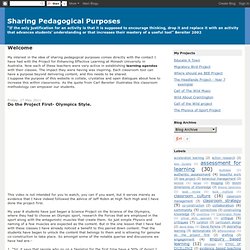
My year 8 students have just began a Science Project on the Science of the Olympics, where they had to choose an Olympic sport, research the Forces that are employed in the sport along with the antagonistic muscles that create them. So just simple Physics and naming of a few muscles are expected as the content. But in the one lesson that I have had with these classes I have already noticed a benefit to this paired down content. That the students have began to unlock the content that belongs to them and is allowing for genuine co-construction to take place. So amongst some of the notable queries and discussions we have had are:- 1. 2. 3. 4. 5. 6.
CREATIVE TALLIS: An alternative curriculum. As part of the Hayward Gallery's Wide Open School in July 2012 members of the Huddle, the Southbank Centre's young people's group, worked with artist Yara El-Sherbini to come up with an alternative syllabus.
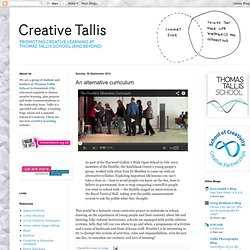
Exploring important life lessons you can't take a class in -- how to avoid people you know on the bus, how to believe in government, how to stop comparing yourself to people you went to school with -- the Huddle staged an intervention in the Royal Festival Hall, taking over the public announcement system to ask the public what they thought. This would be a fantastic cross-curricular project to undertake in school, drawing on the experiences of young people and their curiosity about life and learning. Like cultural institutions, schools are equipped with public address systems, bells that tell you you where to go and when, a programme of activities and a team of backroom and front of house staff.
So what is project based learning? « Exploring ICT. Over the past two weeks I’ve been looking for some succinct and meaningful definitions for the key terms that I will be working with during this unit.
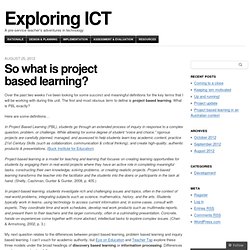
The first and most obvious term to define is project based learning. What is PBL exactly? Here are some definitions… In Project Based Learning (PBL), students go through an extended process of inquiry in response to a complex question, problem, or challenge. While allowing for some degree of student “voice and choice,” rigorous projects are carefully planned, managed, and assessed to help students learn key academic content, practice 21st Century Skills (such as collaboration, communication & critical thinking), and create high-quality, authentic products & presentations.
In project-based learning, students investigate rich and challenging issues and topics, often in the context of real-world problems, integrating subjects such as science, mathematics, history, and the arts.
Quick Overview of Project Based Learning. Project Based Learning - Getting Started + Resources. I looked specifically at High Tech High for methods of starting PBL work in advance of curriculum and timetable redesign, here are a few suggestions: 1.
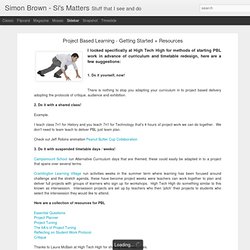
Do it yourself, now!
Project Based Learning - English n that. UnBoxed: online [ Current Issue ]
Sharing Pedagogical Purposes. Checking out a student-made cycling website and cookbook at Cramlington's exhibition of learning. Last weekend, a Learning Futures delegation (David Price and I) went up to Northumberland to see Cramlington Learning Village’s Exhbition of Learning, where students presented the work they’d created during the previous ‘project week’, which they’d spent off timetable.

I went up because Cramlington’s work is informing the guide to project-based learning that I’m writing as part of Learning Futures (version 1.0 coming out in September, reserve your copy now!)
, and I saw a lot of exciting stuff, but there’s two projects that I want to mention in particular: First, Suscram – this is a website full of cycling routes in the local area, which a group of students produced in a week!
It’s an impressive achievement in its own right, but it’s particularly interesting because it’s linked to sustrans, a national ‘sustainable transport’ charity that focuses on getting more people walking, cycling, and using public transport.
Enquiring Minds. K-12 Education & Learning Innovations with Proven Strategies that Work. Project Based Learning. UnBoxed: online [ Current Issue ]
It is 7 am and I’m climbing a tree on the school campus with a bird feeder clenched between my teeth.
![UnBoxed: online [ Current Issue ]](http://cdn.pearltrees.com/s/pic/th/unboxed-online-30748442)
It’s the final bit of preparation for the “Wild about Cramlington” project, part of a weeklong sustainability experience for our 400 Year 9 students. Today, I want the 28 students I am working with to experience just enough failure to act and think in a way different from the normal school day. I know that this is a balancing act, and that they must see enough birdlife to stimulate their interest for the rest of the week. Above all I want the project to lead the learning, not me. Hence the bird feeder and my compromised position in a rather too thorny tree. In class that morning we examine some professionally produced wildlife guides from local nature reserves, along with one I have prepared on Cramlington.
The 28 nascent birdwatchers, armed with field guides and shared binoculars, venture out to spot birds. I respond quietly, “I saw 19 different birds and two species of butterfly.









![UnBoxed: online [ Current Issue ]](http://cdn.pearltrees.com/s/pic/th/unboxed-online-30748442)